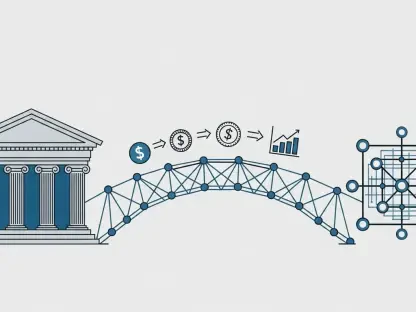In the evolving financial landscape of Mexico, where traditional banking systems often burden borrowers with exorbitant interest rates and leave investors with meager returns, a transformative idea emerged to bridge this gap. Doopla, a groundbreaking crowdfunding platform, was founded in 2015 by Juan Carlos Flores Acevedo with a mission to disrupt this imbalance. Addressing a staggering interest rate differential of nearly 60 percentage points, the platform sought to connect individuals seeking affordable loans directly with investors looking for higher yields. This bold initiative not only challenged the status quo but also set the stage for a new era of peer-to-peer (P2P) lending in a market ripe for innovation. The story of Doopla is one of vision, perseverance, and adaptation, navigating uncharted regulatory waters to become a beacon for fintech advancement in the region.
The Genesis of a Financial Revolution
From Classroom to Marketplace
The inception of Doopla can be traced back to a business school case study at IPADE in 2013, where Juan Carlos Flores Acevedo encountered the concept of P2P lending through the British platform Zopa. Inspired by its potential to revolutionize financial interactions, Flores saw an opportunity to adapt this model to Mexico’s unique economic challenges, particularly the vast disparity between borrowing costs and investment returns. After a year of rigorous planning, which encompassed developing robust technology, establishing legal frameworks, and crafting effective marketing strategies, the platform was launched in 2015. Within months, Doopla facilitated its first loans, marking a significant milestone as borrowers accessed funds at lower rates and investors began to see promising interest payments. This early success validated the concept and hinted at the transformative potential of crowdfunding in a market long dominated by traditional financial giants.
The launch of Doopla was more than just a business venture; it represented a fundamental shift in how financial services could be democratized. By cutting out intermediaries, the platform aimed to create a more equitable system where both borrowers and lenders could benefit from direct transactions. The initial focus on consumer-to-consumer (C2C) lending allowed everyday individuals to participate in a financial ecosystem previously inaccessible to many. Flores’s vision was rooted in addressing systemic inefficiencies, ensuring that the platform wasn’t merely a technological novelty but a practical solution to a persistent problem. Over time, the growing traction among users demonstrated a clear demand for alternatives to conventional banking, setting Doopla on a path to redefine financial inclusion in Mexico with an approach tailored to local needs and aspirations.
Crafting a Mission for Change
At the heart of Doopla’s mission was a commitment to tackle the glaring market distortion caused by Mexico’s interest rate differential. This gap, where borrowers often faced rates exponentially higher than the returns investors could secure, created fertile ground for exploitation by traditional institutions. Doopla positioned itself as a disruptor, leveraging technology to enable direct lending that offered borrowers rates significantly lower than market averages while promising investors yields far surpassing typical savings accounts. This dual benefit became the cornerstone of its value proposition, appealing to a wide range of users frustrated by the inefficiencies of the existing system. The platform’s early adoption signaled a readiness among Mexicans to embrace innovative financial tools that prioritized fairness and accessibility.
Beyond its immediate financial goals, Doopla also aimed to foster a broader cultural shift toward financial empowerment. By providing a transparent and user-friendly interface, the platform encouraged individuals to take control of their financial destinies, whether by securing a loan for personal growth or investing in others’ aspirations. This mission resonated deeply in a country where access to affordable credit has long been a barrier to economic progress. The emphasis on building trust through clear terms and direct interactions helped cultivate a community of users who saw Doopla as more than just a lending tool, but as a partner in navigating financial challenges. This foundational ethos not only fueled early growth but also laid the groundwork for the platform to adapt and expand in response to evolving market dynamics.
Navigating Regulatory Waters
Confronting Early Obstacles
The journey of Doopla was marked by significant regulatory challenges almost from the moment of its launch in 2015. Mexican authorities, unaccustomed to the fintech model, subjected the platform to intense scrutiny, questioning its legitimacy and operational framework. Juan Carlos Flores Acevedo faced personal threats and endured a grueling nine-month correspondence with officials, a period that tested the resilience of both the founder and the nascent company. At a time when fintech was still a novel concept in Mexico, the lack of clear guidelines created a tense environment where innovation often clashed with bureaucratic caution. This early phase highlighted the broader struggle of pioneering a new financial model in a landscape unprepared for such disruption, yet it also underscored the determination required to push boundaries.
The regulatory pressure reached a critical juncture in 2016 during a pivotal meeting with the National Banking and Securities Commission (CNBV). This encounter cleared Doopla of any wrongdoing but came with a mandate for operational adjustments and a call to advocate for industry-wide regulatory frameworks. The outcome was a double-edged sword: while it alleviated immediate legal concerns, it placed additional responsibilities on the platform to align with evolving expectations. This moment was not just a reprieve but a catalyst for Flores to champion the cause of fintech regulation, recognizing that sustainable growth depended on establishing trust and legitimacy within the system. The experience shaped Doopla’s approach, emphasizing the need for collaboration with authorities to create a balanced environment where innovation could thrive without compromising consumer protection.
Achieving a Landmark Victory
The culmination of years of regulatory advocacy came with the passage of Mexico’s Fintech Law in 2018, a groundbreaking piece of legislation that provided a structured framework for crowdfunding and other fintech activities. This law marked a turning point for the sector, offering clarity and legal certainty that had been sorely lacking. By 2021, Doopla achieved a historic milestone by becoming the first authorized Crowdfunding Institution (CFI) in Mexico, a distinction that validated its model and significantly boosted user confidence. The authorization was not merely a bureaucratic achievement; it enhanced the platform’s credibility, opening doors to strategic alliances with other financial entities and reinforcing its position as a trusted player in the market. This regulatory triumph was a testament to years of persistence and strategic navigation through complex challenges.
The impact of becoming a regulated CFI extended far beyond internal operations, influencing how Doopla was perceived in the broader financial ecosystem. Investors and borrowers alike began to view the platform as a safer and more reliable option compared to unregulated alternatives. The legal backing also facilitated partnerships that were previously out of reach, allowing Doopla to expand its reach and influence. Moreover, this achievement set a precedent for other fintech companies in Mexico, demonstrating that compliance, while demanding, could pave the way for long-term success. The journey to this point reshaped the narrative around crowdfunding, proving that regulatory hurdles, though formidable, could be overcome with dedication and a commitment to aligning innovation with systemic stability.
Measuring Impact and Expansion
Scaling a Financial Network
Over the years, Doopla has demonstrated remarkable growth, carving out a significant presence in Mexico’s financial sector with tangible metrics of success. The platform has issued over 750 million pesos in loans, a figure that reflects its ability to meet the needs of a diverse user base. With 20,000 active customers and more than 1 million registered users, Doopla has built a robust community that spans borrowers and investors alike. This scale underscores the demand for alternative lending solutions in a market where traditional options often fall short. The platform’s financial journey, from initial funding through friends and family to engaging angel investors, and now targeting a $2 million raise with institutional backers, highlights a maturing business model poised for further expansion and influence.
The operational impact of Doopla goes beyond numbers, reflecting a deeper shift in how financial services are accessed and perceived. By facilitating direct transactions, the platform has empowered individuals who might otherwise be excluded from conventional banking systems, offering them opportunities to fund personal projects or grow small businesses. This democratization of finance has also attracted a wide array of investors seeking better returns, creating a dynamic ecosystem where mutual benefit drives participation. The growth trajectory suggests a sustained appetite for such platforms, particularly as awareness spreads about the advantages of P2P lending over traditional avenues. Doopla’s ability to scale while maintaining user trust has been central to its role as a transformative force in the region’s financial landscape.
Shifting to New Models
In response to evolving market dynamics, Doopla has strategically pivoted from a purely consumer-to-consumer (C2C) model to incorporate a business-to-consumer (B2C) approach. This shift allows institutional investors, such as financial entities and corporate treasuries, to fund loans, providing them with attractive annual returns ranging from 15-20%. This move positions Doopla as a compelling alternative to low-yield traditional investments, tapping into a new segment of capital that can fuel further growth. By diversifying its investor base, the platform not only enhances liquidity but also strengthens its capacity to support more borrowers, creating a virtuous cycle of financial inclusion and investment opportunity that aligns with broader market needs.
The adoption of the B2C model also reflects Doopla’s agility in addressing the changing priorities of the financial sector. Institutional investors bring not only capital but also credibility, further solidifying the platform’s reputation as a reliable partner. This strategic evolution enables Doopla to scale its operations more effectively, ensuring that a larger pool of borrowers can access affordable credit. Additionally, the higher returns offered to institutional players serve as a powerful incentive, drawing in entities that might otherwise overlook crowdfunding as a viable investment channel. This adaptability highlights how Doopla continues to innovate, responding to both user demands and market opportunities with solutions that maintain its competitive edge in a crowded fintech space.
Looking Ahead with Innovation
Financial Milestones on the Horizon
Financially, Doopla has shown impressive progress, with a debt margin improvement of over 70% in recent years, a clear indicator of operational efficiency and strategic focus. The platform’s trajectory points toward profitability within the near future, a milestone that remains rare among fintech enterprises due to high initial costs and regulatory expenses. Achieving this financial stability would not only validate Doopla’s business model but also set a benchmark for sustainability in the industry. Such progress reflects meticulous planning and a commitment to balancing growth with fiscal responsibility, ensuring that the platform can continue to serve its users while meeting investor expectations in a challenging economic environment.
The pursuit of profitability also signals Doopla’s readiness to transition from a startup mindset to that of a mature financial player. This shift involves optimizing internal processes, enhancing risk assessment mechanisms, and refining user experience to retain and attract a broader audience. The financial improvements are complemented by ongoing efforts to secure institutional funding, which could further accelerate expansion plans. As Doopla approaches this critical juncture, its ability to maintain momentum while navigating market fluctuations will be key to cementing its status as a leader. The focus on financial health ensures that future growth is not just ambitious but grounded in achievable, data-driven goals that prioritize long-term impact over short-term gains.
Crowdfunding as a Lasting Solution
The broader significance of Doopla’s journey lies in its role as a pioneer of crowdfunding in a market plagued by structural inefficiencies. As long as substantial interest rate disparities persist, platforms like Doopla remain essential, offering a viable alternative to traditional banking systems that often prioritize profit over accessibility. The success of this model demonstrates the potential of technology to democratize finance, providing lessons for other emerging markets facing similar challenges. Crowdfunding, as exemplified by Doopla, is not merely a trend but a necessary evolution in how capital is accessed and distributed, challenging entrenched systems with innovative, user-centric solutions.
Reflecting on the past, Doopla’s persistence through regulatory battles and market uncertainties paid off in establishing a regulated framework that benefited the entire fintech sector. Looking forward, the platform’s story offers a blueprint for how perseverance and adaptability can drive systemic change. Future considerations include expanding outreach to underserved communities, leveraging technology for even greater efficiency, and continuing to advocate for policies that support fintech growth. As the landscape evolves, the emphasis should remain on fostering trust and inclusivity, ensuring that crowdfunding continues to serve as a powerful tool for economic empowerment in Mexico and beyond.









